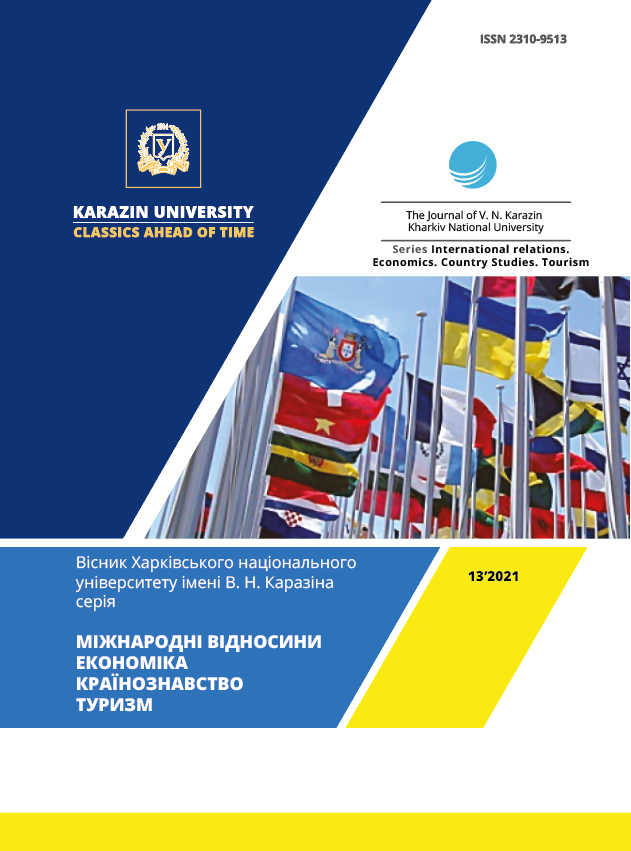Ming empire diplomatic expeditions as an example of economic diplomacy and geoeconomics initiatives of the People’s Republic of China
Abstract
The historical hypostasis of the modern geoeconomic strategy of the People's Republic of China (PRC) is considered, using the example of the diplomatic expeditions of the 15th century by the Chinese travelers Zheng He, Yishiha, and Cheng Cheng in the prism of a political economic and historical materialist approach. The subject of the article is the historical process of Ming China spreading its influence throughout diplomatic missions and expeditions, as well as the modern model of economic diplomacy and geoeconomic strategy of the PRC. The aim is to conduct a comparative study of the geography and methods of influence of emissaries and ambassadors of Ming China with modern geoeconomic initiatives of the PRC in the international division of labor and the world market. The objectives of the work are to determine the geography of historical interests of the Chinese economy and state apparatus; to formulate the principles and features of conducting foreign economic policy of Ming and modern China; to deduce the objective reasons for the historical process and modern initiatives of China. The following results were obtained in the course of the study: the basis of the geoeconomic strategy of the modern PRC, the instruments of economic diplomacy and soft power of China in relations with its neighbors determined; the principles and mechanisms of the prerequisites for the emergence of modern Chinese initiatives on the world stage analyzed; the objective indicators of China's foreign trade cooperation with countries located in geographical proximity to China and the routes of the above-mentioned expeditions considered. Conclusions: the results obtained made it possible to objectively consider the origins of the geoeconomic initiatives of the modern PRC as a synergy of current institutional instruments of influence, objective trade and economic interests and bourgeois-based "national mythology".
Downloads
References
/References
China (CHN) Exports, Imports, and Trade Partners – The Observatory of Economic Complexity. URL: https://oec.world/en/
profile/country/chn?subnationalFlowSelector=flow1&yearSelector1=2021&yearlyTradeFlowSelector=flow0
Mapping Belt and Road Initiative: this is where we stand – Merics. URL: https://www.merics.org/en/tracker/mappingbelt-
and-road-initiative-where-we-stand
Strengthen cooperation to advance the Belt and Road Initiative – CPC Central Comitee Bimonthly Qiushi. URL: http://
en.qstheory.cn/2022-07/18/c_772041.htm
习近平出席第三次“一带一路”建设座谈会并发表重要讲话 – 中国政府网 URL: http://www.gov.cn/xinwen/2021-11/19/
content_5652067.htm
Levathes L. (1996) When China ruled the seas: the treasure fleet of the Dragon Throne, 1405-1433. New York: Oxford
University Press, 1996. 252 p.
廉亚明.《郑和航海图》里的南阿拉伯海岸港口,《海洋史研究》. 2022. 年(1),100-115,共16页。
宋正海、陈传康. 郑和航海为什么没有导致中国人去完成“地理大发现”,《自然辩证法通讯》,1983(1)年,
-31,共8页。
熊小飞、冀开运. 杰出的“丝路”外交家—陈诚,《商洛学院学报》.2015. 年(3),80-84,共5页。
薛克翘. 郑和下西洋二事考,《海交史研究》.2019年(2).15-20,共6页
赵文生. 亦失哈十下奴儿干的历史意义,《哈尔滨学院学报》. 2018年. (11),1-6,共6页。
朱亚非. 郑和外交成就之思考—纪念郑和下西洋600周年,《山东师范大 学学报:人文社会科学版》. 2005年(5).
-79,共4页。
China (CHN) Exports, Imports, and Trade Partners – The Observatory of Economic Complexity. URL: https://oec.world/en/profile/country/chn?subnationalFlowSelector=flow1&yearSelector1=2021&yearlyTradeFlowSelector=flow0
Mapping Belt and Road Initiative: this is where we stand – Merics. URL: https://www.merics.org/en/tracker/mapping-belt-and-road-initiative-where-we-stand
Strengthen cooperation to advance the Belt and Road Initiative – CPC Central Comitee Bimonthly Qiushi. URL: http://en.qstheory.cn/2022-07/18/c_772041.htm
Xí Jìnpíng chūxí dì sān cì “Yīdài Yīlù” jiànshè zuòtán huì bìng fābiǎo zhòngyào jiǎnghuà [Xi Jinping attended the third symposium on the construction of the Belt and Road Initiative and delivered an important speech] – Zhōngguó zhèngfǔ wǎng [Official website of the Chinese Government] URL: http://www.gov.cn/xinwen/2021-11/19/content_5652067.htm
Levathes L. (1996) When China ruled the seas: the treasure fleet of the Dragon Throne, 1405-1433. New York: Oxford University Press.
Lián Y.M. (2022) “Zhèng Hé hánghǎi tú” lǐ de nán ālābó hǎi'àn gǎngkǒu. [South Arabian Coast Ports in “Zheng He hangtai tu”.] “Hǎiyángshǐ yánjiū” [Maritime History Research], vol. 1, pp. 100-115.
Sòng Z.H., Chén C.K. (1983). Zhèng Hé hánghǎi wéi shén me méiyǒu dǎozhì Zhōngguó rén qù wánchéng “Dìlǐ Dà Fāxiàn” [Why Zheng He's voyages did not lead the Chinese to complete the "Great Geographical Discovery"]. “Zìrán biànzhèngfǎ tōngxùn” [Journal of Dialectics of Nature], vol. 1, pp. 25-31.
Xióng X.F., Jì K.Y. (2015) Jiéchū de “sīlù” wàijiāojiā – Chén Chéng. “Shāngluò xuéyuàn xuébào”, vol. 3, pp. 80-84.
Xuē K.Q. (2019) Zhèng Hé xià xīyáng èr shì kǎo [Study of the Two Voyages of Zheng He to the West]. ,“Hǎijiāoshǐ yánjiū” [Journal of Maritime History], vol. 2, pp.15-20.
Zhào W.S. (2018) Yì Shīhā shí xià nú ér gàn de lìshǐ yìyì [Historical significance of Yishiha's tenth expedition to Nurgan]. “Hā'ěrbīn xuéyuàn xuébào” [Journal of Harbin University], vol. 11, pp. 1-6.
Zhū Y.F. (2005) Zhèng Hé wàijiāo chéngjiù zhī sīkǎo—jìniàn Zhèng Hé xià xīyáng 600 zhōunián [Reflections on Zheng He’s diplomatic achievements: Commemorating the 600th anniversary of Zheng He’s voyages to the West]. “Shāndōng shīfàn dàxué xuébào: Rénwén shèhuì kēxué bǎn” [Journal of Shandong Normal University: Humanities and Social Sciences], vol. 5, pp. 76.
Authors who publish with this journal agree to the following terms:
- Authors retain copyright and grant the journal right of first publication of this work under the terms of a license Creative Commons Attribution License 4.0 International (CC BY 4.0).
- Authors are able to enter into separate, additional contractual arrangements for the non-exclusive distribution of the journal's published version of the work (e.g., post it to an institutional repository or publish it in a book), with an acknowledgement of its initial publication in this journal.
- Authors are permitted and encouraged to post their work online (e.g., in institutional repositories or on their website) prior to and during the submission process, as it can lead to productive exchanges, as well as earlier and greater citation of published work.




